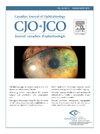眼表鳞状细胞瘤:侵袭性生长行为的危险因素和Ki-67的作用。
IF 2.8
4区 医学
Q1 OPHTHALMOLOGY
Canadian journal of ophthalmology. Journal canadien d'ophtalmologie
Pub Date : 2025-10-01
DOI:10.1016/j.jcjo.2025.03.018
引用次数: 0
摘要
目的:分析眼表鳞状细胞瘤(OSSN)的初诊特点及侵袭性生长行为的潜在危险因素。设计:回顾性。方法:纳入2013年至2022年在某三级中心首次诊断为OSSN的患者。分析病例的人口统计学、临床表现和组织病理学结果,包括Ki-67表达。结果:共纳入153例首次诊断为组织病理学证实的OSSN患者。平均年龄72岁(36-98岁),男性稍占优势(66%;n = 101)。大多数患者为浸润性鳞状细胞癌(SCC);45.8%, 70),其次是原位癌(CIS;37.9%, 58)和上皮发育不良(ED;16.3%, 25)。症状持续时间差异显著:ED 6个月(0-36),CIS 1.5个月(0-48),SCC 3个月(0-36)(p = 0.048)。44.3%(51/115)的病例以前被误诊,因此没有得到充分治疗。在最初诊断时,眼眶受累率为8.5%(13例),眼内受累率为1.3%(2例),转移率为2.7%(4例)。Ki-67标记指数(LI)在不同亚型之间差异显著:ED为35% (2-87%),CIS为45% (11-85%),SCC为50% (18-93%)(p = 0.007),并且在肩关节、下窝、下睑缘或跗骨受累时较高(p = 0.023)。侵犯眼球或眼眶的患者中位症状持续时间明显更长(6个月(0-48)vs 2个月(0-48); = 0.01页)。转移患者Ki-67 LI明显升高(p = 0.027)。结论:我们的研究发现,从首次出现症状到首次正确诊断的时间间隔延长与晚期SCC的高风险相关。此外,Ki-67 LI升高与侵袭性更强的肿瘤实体(如SCC和CIS)相关,表明转移风险增加。本文章由计算机程序翻译,如有差异,请以英文原文为准。
Ocular surface squamous cell neoplasia: risk factors for aggressive growth behaviour and the role of Ki-67
Objective
Analyzing characteristics of ocular surface squamous cell neoplasia (OSSN) at first diagnosis and potential risk factors for aggressive growth behaviour.
Design
Retrospective.
Methods
Including patients with first diagnosis of OSSN at a tertiary center from 2013 until 2022. Cases were analyzed regarding demographics, clinical findings, and histopathological findings, including Ki-67 expression.
Results
A total of 153 patients with first diagnosis of histopathological confirmed OSSN were included. Mean age was 72 years (36–98), with a slight male predominance (66%; n = 101). Most patients had invasive squamous cell carcinoma (SCC; 45.8%, 70), followed by carcinoma in situ (CIS; 37.9%, 58) and epithelial dysplasia (ED; 16.3%, 25). Duration of symptoms varied significantly: ED 6 months (0–36), CIS 1.5 (0–48), SCC 3 (0–36) (p = 0.048). 44.3% (51/115) of cases were previously misdiagnosed, and, therefore, inadequately treated. Orbital involvement was observed in 8.5% (13), intraocular in 1.3% (2), metastasis in 2.7% (4) at initial diagnosis. Ki-67 labeling index (LI) varied significantly across subtypes: ED 35% (2–87%), CIS 45% (11–85%), SCC 50% (18–93%) (p = 0.007) and was higher with involvement of the caruncle, lower fornix, lower eyelid margin, or tarsus (p = 0.023). Patients with globe or orbit invasion had significantly longer median symptom duration (6 months (0–48) vs 2 (0–48); p = 0.01). Patients with metastasis exhibited significantly higher Ki-67 LI (p = 0.027).
Conclusions
Our study found extended time intervals from first symptoms to first correct diagnosis correlate with higher risk for advanced SCC. Further, elevated Ki-67 LI correlated with more invasive tumor entities, such as SCC and CIS, and indicate an increased risk of metastasis.
Objectif
Analyser les caractéristiques du carcinome épidermoïde de la surface oculaire (CESO) lors du diagnostic initial de même que les facteurs de risque éventuels d’une croissance agressive.
Nature
Étude rétrospective.
Méthodes
Patients ayant reçu un diagnostic initial de CESO dans un centre de soins tertiaires entre 2013 et 2022. On a procédé à l’analyse des données démographiques, des observations cliniques et des caractéristiques histopathologiques, notamment l’expression de la protéine Ki-67.
Résultats
Au total, on a retenu 153 patients dont le diagnostic initial de CESO a été confirmé par histopathologie. L’âge moyen était de 72 ans (36-98 ans), et le nombre d’hommes était légèrement plus élevé (66 %; n = 101). La plupart des patients présentaient une forme invasive de cancer épidermoïde (CE; 45,8 %; 70), un carcinome in situ (CIS; 37,9 %; 58) ou une dysplasie épithéliale (DE; 16,3 %; 25). L’ancienneté des symptômes variait significativement : 6 mois (0-36 mois) dans le cas de la DE, 1,5 mois (0-48 mois) dans le cas du CIS et 3 mois (0-36 mois) dans le cas du CE (p = 0,048). Le diagnostic antérieur de 44,3 % des patients (51/115) était erroné, de sorte que ces patients ont reçu un traitement inadéquat au départ. Lors du diagnostic initial, on recensait une atteinte orbitaire dans 8,5 % des cas (13), une atteinte intraoculaire dans 1,3 % des cas (2) et des métastases dans 2,7 % des cas (4). L’indice de marquage (IM) de la protéine Ki-67 variait significativement en fonction des sous-types : 35 % (2-87 %) dans le cas de la DE, 45 % (11-85 %) dans le cas du CIS et 50 % (18-93 %) dans le cas du CE (p = 0,007); il était plus élevé en présence d’une atteinte de la caroncule, du fornix inférieur, du bord de la paupière inférieure ou du tarse (p = 0,023). La durée médiane des symptômes en présence d’un envahissement du globe ou de l’orbite était significativement plus longue (6 mois [0–48] vs 2 [0–48]; p = 0,01). L’IM de la protéine Ki-67 était significativement plus élevé en présence de métastases (p = 0,027).
Conclusions
Notre étude a mis au jour une corrélation entre l’allongement de l’intervalle entre les premiers symptômes et le diagnostic exact, d’une part, et un risque plus élevé de CE avancé. De plus, il existe une corrélation entre une élévation de l’IM de la protéine Ki-67 et la présence de tumeurs plus invasives, comme le CE et le CIS, cette élévation annonçant un plus grand risque de métastases.
求助全文
通过发布文献求助,成功后即可免费获取论文全文。
去求助
来源期刊
CiteScore
3.20
自引率
4.80%
发文量
223
审稿时长
38 days
期刊介绍:
Official journal of the Canadian Ophthalmological Society.
The Canadian Journal of Ophthalmology (CJO) is the official journal of the Canadian Ophthalmological Society and is committed to timely publication of original, peer-reviewed ophthalmology and vision science articles.

 求助内容:
求助内容: 应助结果提醒方式:
应助结果提醒方式:


